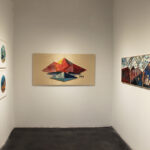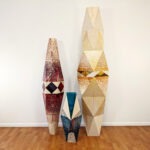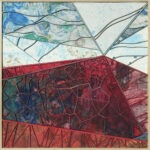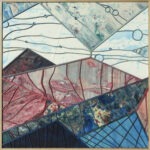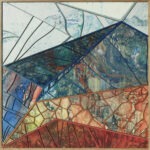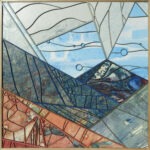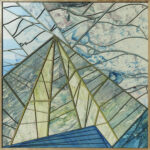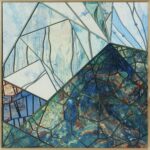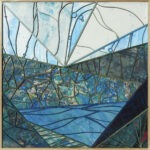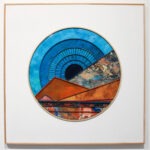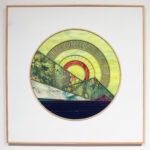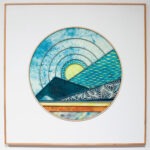Collages
This body of work, Collages, navigates the landscape and texture of the past 18 months in wood, glass and paper. These experiments with hand-marbled paper, laser-cut birch and art glass in relief and three dimensions reflect an escape into pattern, iteration and nature during a personally and globally tumultuous time. I’m honored by the opportunity to share these explorations.
Works
Range Panels (9 total)
- 20.5” wide x 20.5” high x 1” deep each
- ~186.5” wide installed
- Birch plywood, paper
Chatoyant Panels (4 total)
- 20.5” wide x 20.5” high x 1” deep each
- Birch plywood, paper
Collage Panel
- 60” wide x 30” high x 2” deep
- Birch plywood, paper
Experimental Polyhedron 1
- 14“ wide x 28.75“ high x 14“ deep
- Birch plywood, paper, glass
Experimental Polyhedron 2
- 14“ wide x 63“ high x 16“ deep
- Birch plywood, paper, glass
Experimental Polyhedron 3
- 21“ wide x 82“ high x 21“ deep
- Birch plywood, paper, glass
Artist Talk
Thank you so much for the opportunity to share my work here, with Alanna, the IGCA team, and all of you in person and on Facebook – hi out there!
What a wild, unexpected 18 months this has been! I’m sure each of you could come up and share about your experiences during COVID and the many other current events we’ve all been through, and I hope we have time to reconnect here through all the fantastic programs here at the IGCA.
To introduce myself, I was born and raised here in the Anchorage area, and I’ve been making art and wanted to be an artist since I was a kid. My parents encouraged to try a little of everything, so my art interests have included drawing, painting, beadwork, origami, sewing, quilting, and pretty much any medium that was available. I didn’t study art formally in college, but always had a sketchbook going, and a few years back decided to take art classes full time at UAA to explore clay and design. I’d been doing some graphic design work for my family’s business for a few years, but I found that I really enjoyed the combination of sketching and then digitizing the design to create something versatile that someone could use across print media and online.
Working for my dad on our family farm gave me an appreciation for small businesses as an opportunity to learn something totally different with each new client, and most of my design projects combined some sort of analog process with the digital side. I also worked at a small IT shop and as an in-house graphic designer where I learned a lot about the business of design, and kept making and showing art.
So, after meeting a great guy at a wood firing, who also happened to be working on his BFA and then got in to grad school, I decided to move to Phoenix with this guy and strike out on my own as a freelance graphic and web designer while he worked on his MFA in Ceramics at ASU. Spoiler, we got married, so watch out who you fire kilns with!
I’d left Alaska with no job or real firm plans before, so I figured it would totally work out, right?! *Not recommended* for anyone looking for career advice, but I lucked out with a great opportunity to work at a place called TechShop, that was a kind of gym for technical equipment: they had about a million dollars of tools of every kind, including laser cutters, 3D printers, a full wood shop with CNC routers, machine shop, welding shop, powder coating rig, a water jet, an electronics lab, industrial sewing equipment, tons of design software, and classes to learn how to use all the tools and programs. Once you were a member, you could go in 24 hours a day, and they had unlimited coffee and popcorn, so you know when it was 115 degrees, I was there to stay!
I took *one class* on the long arm quilting machine, since I’d learned how to quilt from my mom, and then they offered me a job as the instructor – yikes! This did give me the chance to take almost every class that they offered, and I had almost three years to experiment with the equipment. One of the benefits of freelancing was the chance to spend time with the art grad students, plus the working professionals that ran their businesses or maker space hobbies from TechShop, and I got to know the staff with different art and design backgrounds and interests of their own.
The desert landscape had been a big part of wanting to live in the Southwest, and again thanks to being a freelancer, I had the chance to really explore and stockpile images, drawings, and experiences that contrasted with the Alaskan landscape. I think I went to the Grand Canyon 10 times just because it was so close – I couldn’t get enough and still can’t wait to go back for more canyon!!!
I’ve been lucky enough to travel quite a bit, so I kept finding common themes across my sketches, things like patterns, the common forms across macro and micro scales, and all kinds of nerdy science and computer science things like space filling principles, generative design, and biomimicry.
I made several bodies of work using a combination of analog tools, including mixed media sculpture, artist books, and map quilts, and I also did a 365-day design project that helped me explore the digital side of my work. I was able to get feedback on this big variety of work through a few shows. when we came back to Alaska after my husband graduated, I wanted to keep going with some of these ideas, like capturing both the vastness and intimacy of nature, and my personal *thing* of finding patterns and using subtractive processes to reinterpret photos and basic drawings in other materials.
So with that in mind, I’d like to share a pretty personal story about where this body of work came from. To go back a bit further than the pandemic and beyond art just a bit, in 2018, my husband and I had been hoping to adopt a baby here in the US, and we connected with a birth mom in time to fly in just after she delivered a baby girl. But, after we took the baby home from the hospital and cared for her for 10 days, the birth father intervened in the adoption process, and we ended up giving her back to her birth mom. We had all the support of our family and friends, but it was still a shattering experience for me, and grieving a baby that we weren’t able to bring home was very difficult.
Of course, I didn’t want to give up on having a family, so I threw myself into work, family, and a lot of time outdoors to try to cope. Making artwork directly about the failed adoption didn’t seem to get very far, but I kept trying, and expanding on past projects and techniques, and bought a laser cutter so I could continue combining digital and analog processes in new ways. All along the way, my husband and I would receive leads on potential adoption situations, many of which were so heartbreaking, but for over a year, we didn’t match up with any new birth moms.
So now, to fast forward to late 2019, we connected with a new birth mom, who was expecting a baby in the early spring. Everything went pretty smoothly, despite a lot of fear and worry about what could happen this time, and in February 2020, we flew to meet the birth mom and (spoiler) we were able to meet *our daughter* at the hospital the day she was born. Of course, at this time, the pandemic was just ramping up overseas, and so we flew home just days before many airports closed. The legal process was complicated by the pandemic, so I lived on a tightrope waiting for the final hearings and approval of the adoption to go through.
So, now we had a brand new baby at home in the middle of a pandemic, with no vaccine: easy peasy! Making art with babies and little kids is always pretty challenging, but this was a pretty weird time: thankfully we lucked out with a really happy kiddo who likes being outside, so I was able to again spend a lot of time walking, hiking, skiing and biking, and also squeezed in making artwork in very small bits of time.
Maybe because of the more than 3 year shakeup, I found that I couldn’t quite return to the old mindset and style of working that I had used before, so I tried a LOT of experiments. As a former chemistry student, I had my lab notebook out in the garage, testing combinations of all kinds of materials, shapes, patterns, textures, and techniques, and of course most of them didn’t work, but a few that you see here were interesting enough that I thought I could share them.
At TechShop, I learned how to hand-marble paper in a kind of grungy, nontraditional way, using oil paint on water, and because it has a big setup and cleanup process, you “might as well” make a LOT of sheets while you’re at it – so I ended up with a wide variety of textures and patterns from the macro to the micro level. Some look like stone, or tiny mountain ranges, or many other weird and unexpected shapes and colors together.
From there, I worked on building shapes and color combinations that echoed everything I’d seen outdoors, and also to feel a coming together of the little pieces that had broken apart during the crazy adoption experience and reforming my identity as a new parent. The thing that I’ve always loved about collages, and here I have to credit drop Anais Nin and her book Collages as a huge source of inspiration, is that the process gets so chaotic that sometimes you don’t know what you’re going to turn over, and that chance does a little bit of the work.
Thanks to having my laser at home, I was able to design the 3D sculptures and cut the overlay for the very long collage *here*, which I’d made as one long piece but just didn’t seem finished as a collage on its own. One of the limitations of TechShop was that machine time on the really popular equipment, like the laser cutters, was limited, and pieces like this one that just required a lot of time, would have been pretty hard to make. Having a shared space was also a challenge, since you can’t leave work out to ruminate on if you want – I’m very thankful to have a home studio where I could stockpile and reuse many of the extra pieces to make the panel at the end *there*.
One of the ideas I’m still exploring is how to best take advantage of the laser, which is really good at both making one-off designs that would be cost prohibitive to make with other industrial processes, or, just plain impossible to make by hand, and also really good at making multiple copies of complicated shapes. I’m working on a balance of the time to design and digitize new and designs, versus trying repeating and mirroring to create more complexity from something simple. So, my test this time was the repeating pattern on the four panels *here*.
The process of combining and shaping these random pieces of paper and wood turned over a lot of memories and emotions that were unexpected, and even though the failed experiments and weird test pieces that went to the recycling bin were frustrating, they felt like progress toward honoring the past, appreciating the present (even when it seems impossible), and slowly putting together an idea of the future using all those elements.
I fully own up to really loving three things – my family, mountains and my X-acto blade – and I know that the whole personal saga of adoption isn’t visually part of this show, but I can say for sure that this work really helped me get through a difficult time, and the feeling that our community is out here continuing to work in so many different ways is in each and every little cut.


